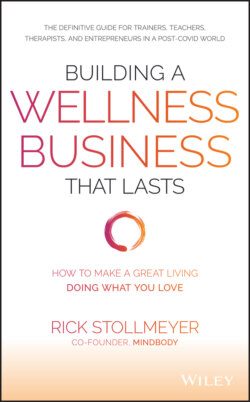Читать книгу Building a Wellness Business That Lasts - Rick Stollmeyer - Страница 16
The Second Wave of Wellness (1997–2010): Gen-X-Driven and Internet-Enabled
ОглавлениеIn the mid-1990s, the first cohorts of Generation X reached their 30s and began to adopt wellness practices alongside their Boomer elders, and before long they began to reshape the industry with their decidedly different personalities.
The Gen-X personality is commonly characterized as more independent, individualistic, and pragmatic than Boomers. Blake Beltram and I are Gen-Xers, and we know their experiences and personalities well. We experienced the social upheavals of the 1960s and 1970s as children, and became adults in the time of the AIDS epidemic. Often called the “latchkey generation,” we were far more likely than Boomers to have divorced or dual-income-earning parents. We encountered drugs and alcohol at an earlier age and witnessed the excesses of our Boomer causes and ideologies first-hand. Growing up faster and harder than our Boomer elders, Gen-Xers are classically more skeptical and independent-minded. These characteristics make us more entrepreneurial as well.
Whereas the First Wave of wellness was characterized by homogenized brands and large, multi-purpose health clubs, the Gen-X-led Second Wave was driven by specialized practices and locally authentic independent studios. These smaller-footprint businesses had a key feature of much lower startup costs and significantly less financial risk than the Boomer-led health clubs. In the late 1990s, thousands of Gen-X-led yoga, Pilates, and indoor cycling studios began to spring up, providing their trailing-edge Boomer and Gen-X clientele with more personalized wellness experiences.
Due to their smaller scale, these smaller studio businesses could not afford the expensive client-server software that had been created for health clubs, and that software didn't meet their specialized scheduling, client, and staff management needs anyway. Therefore, for the first several years of the Second Wave, most of these early boutique wellness studios ran on pencil and paper, which restricted their ability to grow. That technology gap would become the opportunity that Blake Beltram and I founded Mindbody to address in 2000.
At first, the operators of large health clubs saw the boutique wellness movement with a blend of dismissiveness and curiosity. In 2005, the first year that Mindbody had a booth at the annual IHRSA conference, the preeminent fitness industry event of the day, there were no other boutique wellness brands represented in the exposition hall. We were such an oddity that the conference staff misunderstood the online nature of our software and misspelled our company name. Our badges and the trade show guide described us as “mind and body on the line.” We spent that first conference explaining to bemused health club operators that we were in fact a Cloud software company. Their ambivalence toward us and the boutique wellness movement would soon change.
A few years later, a successful health club operator approached me at our IHRSA booth and complained, “Thanks to you, dozens of these little fitness studios have popped up to steal all my members. I feel like Gulliver being surrounded by the Lilliputians!”
That club operator's experience and response reflected a transition happening all over the globe. Changing consumer tastes and a disruptive technology had fueled a shift in the wellness industry. Tens of thousands of boutique fitness studios had emerged, leveraging the latest technologies of the day to provide a more compelling customer experience at a fraction of the cost. It would be several more years before a significant number of club operators would begin to shift their business models, while many of them would linger in Elisabeth Kübler-Ross's first two stages of grief—denial and anger.
During the Second Wave of wellness our world was hit with multiple crises—the dot-com bust and recession of the early 2000s, the 9/11 attacks and War on Terror, the Financial Crisis of 2007 and 2008, and the long, slow recovery of 2009–2010. Rather than slowing the Second Wave down, each of these challenges actually stimulated wellness industry innovation and growth.
In each of these crises, millions more people faced with increased stress and reduced household incomes de-prioritized big-ticket purchases and prioritized self-care, social connections, and affordable luxuries. Crises fueled more demand for wellness services.
Meanwhile, on the business side, corporate layoffs caused tens of thousands of new wellness entrepreneurs to enter the market with new businesses. At Mindbody, we called these people the “Corporate Refugees,” and their energy, resources, and business acumen vastly increased the supply of high-quality local wellness experiences. Several of the boutique brands launched by corporate refugees would go on to become some of the most successful wellness brands we know today (see Figure 3.1).
As these well-known brands prove, crises present opportunities, and you don't have to wait for good times to launch a successful business. In fact, times of recession and strife are the best times to launch an innovative brand.
The Second Wave of wellness firmly established the boutique wellness movement, greatly expanding the size, diversity, and positive impact of the industry. That set the stage for a third and even larger wave of wellness, fueled by the proliferation of smartphones and other connected devices, and the emergence of the largest wellness-oriented generation yet.
Figure 3.1 Examples of Successful Wellness Brands, 2001–2010
